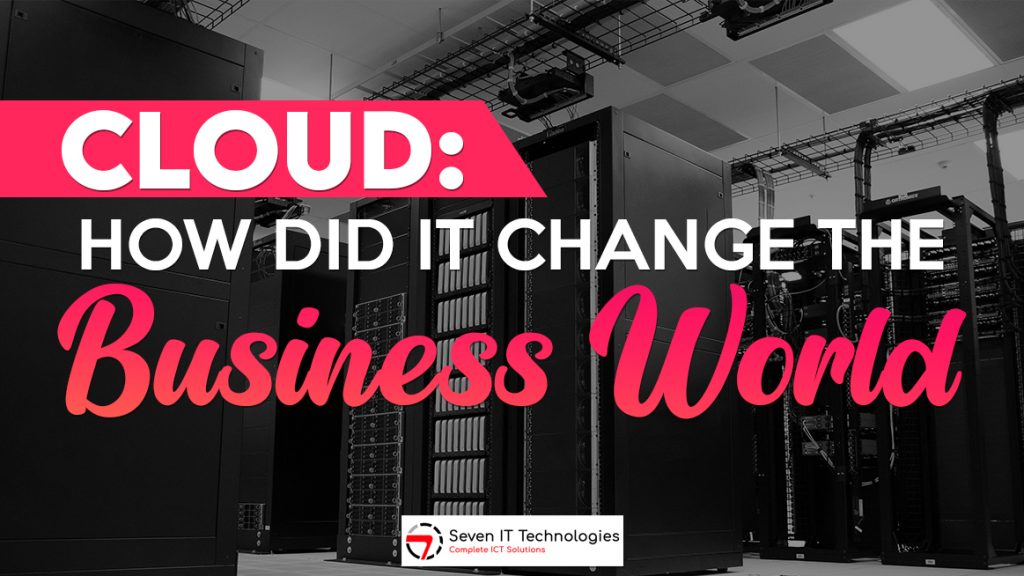As a business owner, it is critical that you understand why cloud for business is important to adopt. I believe it is safe to conclude that COVID-19 has sped up the development of the cloud, which would have taken another two to three years without it. Due to the year’s rapid development and changes, businesses are likely a few years away from shifting at least compiling a portion of their infrastructure to accelerate their timeframe. These changes indicate the magnitude of the cloud’s impact on the planet.
What is the Cloud?
Before continuing, let’s take a moment to answer the simple question, “What is a cloud?” The cloud is the delivery of services through a private or public data center, as opposed to local servers and hardware (also known as cloud computing). As a result of the cloud, organizations may now utilize the most advanced hardware without worrying about maintenance. Despite paying for the service, businesses are no longer saddled with major capital expenses or the necessity to engage employees only for hardware maintenance and upkeep.
Hybrid Cloud
When most individuals discuss the cloud, they often refer to either a private cloud (their cloud) or a public cloud (Microsoft Azure, Amazon AWS, etc.). Businesses assess which cloud configurations work best for them as more workloads shift to the cloud. It could include a combination of on-premises infrastructure and private and public clouds. Frequently, a hybrid cloud is utilized to help businesses shift to the cloud or to discover a mix that makes the most remarkable economic sense.
Cloud Waste
Cloud waste is undoubtedly one of the most debated topics for 2020. According to Devops.com, “cloud waste will surpass $17.6 billion by 2020, spurred by a spike in cloud expenditure.” That is a substantial sum!
Many firms may have been oblivious of their cloud waste problems for some time. Moving a company’s infrastructure to the cloud can result in cost savings. Still, it takes time to understand how to strike a balance between performance and cost reductions. I believe that once this is accomplished, more enterprise cloud storage solutions will begin to save money and make better use of their cloud infrastructure.
How Did it Change the Business World?
Undoubtedly, the cloud has impacted the modern world, but what specific features have evolved in recent years?

Learning
Another important distinction is how we learn. Previously, primary through college-level pupils would attend school and sit and listen to an instructor with an equivalent education. There is a limit to the number of students a teacher can effectively instruct in a classroom. For most people on earth, travel to that classroom is prohibitively expensive.
Solution? They are in abundance. The first is online distance education. It is a common tactic employed by young homeschooled children. Most colleges and secondary schools now require students to take at least one online course, and many earn their whole degrees online. This approach has the potential to train a substantial number of extra individuals. Khan Academy, for instance, was inspired by a distant relative’s need for guidance and education. This website now delivers Web-based training in various disciplines and languages.
WebEx, GoToMeeting, and other similar services provide online group meetings, enabling global project collaboration. People may view and exchange papers, see one other, and collaborate from virtually anywhere.
E-books are an additional, more widespread method in which the Internet has altered our educational system. The youth like to carry a library on their e-reader or tablet, while the elderly enjoy altering the font size as their eyesight weakens. Frequent travelers value the ability to always have a book to read without having to lug about cumbersome volumes.
Health

Medical imaging will change the delivery and administration of healthcare. Although it currently has the most significant impact on hospitals, physicians, and other healthcare organizations, it will eventually affect our daily lives.
Electronic medical records keep all your healthcare information online so other doctors can access it without paperwork. At least in the United States, you have the legal right to see your medical records whenever you choose.
Telemedicine, in which a physician diagnoses a patient’s condition through video instead of an in-person visit, is still in its infancy but growing in popularity. It is especially advantageous for individuals who reside in remote places or require specialist treatment unavailable locally. The capacity for a physician to direct a surgical robot remotely is the cutting edge of this technology.
File Storage and Sharing
The next issue is file sharing and online storage files. You were sharing in the early days of computers storing only a few megabytes of data on floppy disks. Iomega Zip drives with 100 MB of storage were introduced to remedy the issue. Other businesses later boosted the capacity to a gigabit or more. However, you still had to carry cartridges and connect a device to get the data from them.
Even though they were increasingly prevalent, writeable CDs and DVDs were not always the most practical, especially when syncing data fast. Having servers that different employees could access at work made document sharing simple.
Cloud-based file sharing, on the other hand, enables you to access your images, information, or anything else you like on any device, anytime and wherever you want. The concept has existed for almost six years. Still, it has recently gained traction as iPhone, iPad, and Google’s Android operating system users save their images and documents in the cloud. Microsoft Office and email users use OneDrive. These services permit users to upload files to the cloud and share them with family, colleagues, and coworkers.
There are numerous online file storing and sharing services available. Dropbox is likely the most popular. Files can be uploaded to the cloud, synchronized across all of the user’s devices, and accessible through a Web browser from devices the user does not own.
Backup and Disaster Recovery
Most individuals neglect to create backups, yet when a hard disk fails, they regret the lost files, photographs, etc. The cloud can assist with a portion of this; however, deleting a file locally will also delete it from the cloud. A virus assault or the deletion of files to clear space on a device may have unintended effects on files saved on other devices.
Make backups on floppy disks, Zip drives, etc. (and the number today is fewer than 25 percent who backup at least monthly and only 7 percent for those who do it daily). Although introducing USB hard drives with terabytes or more storage space simplified matters, users must still remember to back up their data. For instance, if a fire broke out, the backup lost the original data from the exact location.
Because many businesses did not make and maintain backups with the utmost care, the same issues recurred regularly. Many individuals did not regularly back up their data. When they did, it was typically on tape, which was prone to failures. Even though tape can be kept off-site, many organizations disregard this fundamental notion.
Mobile Apps
The use of mobile applications on tablets and smartphones is an additional exemplary use of cloud computing. Data is frequently stored on servers and used locally. It may be compiled from numerous devices, aggregated, and then disseminated to users, as in the case of Waze’s traffic updates or Google Transit’s bus schedule and location-specific directions.
Microsoft Office, for instance, processes documents locally but stores them in the cloud. Numerous games store information about your score, level, etc., in the cloud. E-readers function identically. When reading on a Kindle or Kindle app, you can effortlessly move between devices because synchronized the last page read on each device.
Highlights, notes, and other items are automatically synchronized and stored in the cloud across all devices. Numerous of the previously mentioned educational applications fulfill the same function.
Social Media
In the past, you had to phone or write your pals to keep up with their lives. Even while many people send out Christmas cards and other such products annually, social media has altered how most people connect.
More than a billion people use Facebook, not to mention Instagram, Snapchat, Twitter, and other social networking sites. This category is so well-known that there is little to say about it.
Internet of Things (IoT)
In the past, when our goods, such as vehicles, dryers, and light bulbs, malfunctioned, we either replaced them or took them to a professional for diagnosis and repair. This someone, like a physician, would possess the knowledge and use it to determine what was wrong and how to treat it. It was a process of trial and error, similar to that of a physician. It often took multiple attempts to determine the underlying problem and how to solve it.
When computers were integrated into many of this equipment, they gave the repairman an error code to identify the problem, which increased the possibility of mending it successfully on the first attempt. Consequently, when a breakdown does occur, there is considerably less downtime, but it is still uncomfortable.
According to experts, many billions of gadgets are anticipated to be connected to the Internet in the next five years. Here we have the Internet of Things (IoT). It was not the case, unlike today when most Internet objects are devices with humans in front of them. In the future, many of these technologies will not interface with humans directly.
Final Thoughts
Ultimately, the goal of every business is to generate a profit from Amazon to the neighborhood corner store. If the business were not profitable, it would cease to exist. In addition, as technology progresses, organizations that do not adapt fall behind. Numerous notable companies, such as Polaroid and Blockbuster, have failed to adapt and grow with technology, resulting in their demise. The cloud is the future of business.
As it grows and spreads, the cloud is becoming its industry. It will be intriguing to discover what the cloud offers in the following years. Although I do not believe that hosting all infrastructure and data in the cloud, I believe that the majority will be.
If you need advice from a cloud professional, don’t hesitate to call Seven IT; they offer the services your business has been searching for.



